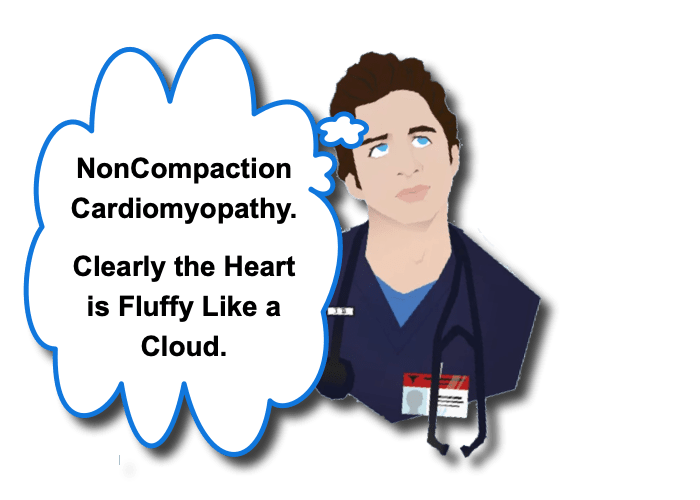Noncompaction Cardiomyopathy in Children

You all may not agree with everything that is written within the Morsels, but no one can argue that Scrubs is the absolute best and most realistic medical TV series. Sure, ER was groundbreaking with its fantastic cinematography and intense drama, but the true heart of medicine and ridiculousness of life is best seen within the scenes of Scrubs. JD’s inner voice seems to be ever present in the ED (or maybe that is just me… hmm… maybe I should keep that thought to myself). Recently, I found myself having a JD-inner-monologue-moment when a patient presented chest pain and a history of Noncompaction Cardiomyopathy. “Sure… I know what that is. It is when the heart is not compacted. Wait… it is supposed to be compacted? Compacted like in Star Wars? Hmmm… Chewbacca.” Fortunately, my outer-response was more in line with what follows. To help ensure you don’t struggle as I did, let’s take a minute to digest a mental morsel on Noncompaction Cardiomyopathy in Children:
Noncompaction Cardiomyopathy: Basics
Refers to heart disease that is related to an abnormal, spongy myocardium. [Rohde, 2021]
- Has thickening of the myocardium in two-layered pattern:
- Thickened noncompacted endocardial layer
- Compacted thin epicardial layer
- Noncompacted / Compacted ratio = >2 (at end-systole)
- Has multiple, prominent trabeculations (“hyper-trabeculated honeycomb-like myocardium”).
- Has deep intertrabecular recesses.
- Has an extended pericardial sac.
- Has no septal hypertrophy.
- Has changes are most pronounced in the apical region of the heart.
- Has segmental or global cardiac dysfunction.
Is rare, but just becoming recognized. [Rohde, 2021]
- Wasn’t recognized as a distinct cardiomyopathy until 2006.
- 1st described in 1984.
- Has had several names (ex, spongy myocardium, left ventricular hypertrabeculation)
- It is rare, but the lack of universal definitions has likely lead to reduced appreciation for its true incidence.
- While rare, it is still the 3rd most common cardiomyopathy in children (Dilated and Hypertrophic cardiomyopathies are more common).
May be an isolated or non-isolated phenotype. [Rohde, 2021]
- Non-isolated phenotypes can be associated with other congenital heart disease and/or other neuromuscular diseases.
- Non-isolated phenotypes can also be seen concurrently with other cardiomyopathies (further complicating identification).
Noncompaction cardiomyopathy likely related to arrest of normal embryogensis. [Rohde, 2021]
- The heart is derived from a simple tube with two layers of cells (epithelial and endothelial) and a cardiac substance that is between the two.
- The cardiac substance is replaced by muscle as the heart increases in size.
- Initially, the heart muscle is sponge-like, allowing the cells to receive oxygen and nutrients.
- Compaction of the myocardium usually occurs in the 5th to 8th week of fetal life.
- Proceeds from basal to apical segments.
- Proceeds from the septal to the lateral walls.
- This is why noncompaction cardiomyopathy predominantly affects the apical region.
Noncompaction Cardiomyopathy: Presentations and Problems
Presentations vary [Rohde, 2021]
- Non-isolated noncompaction cardiomyopathy is often similar to that of the associated congenital heart disease.
- Isolated noncompaction cardiomyopathy often presents with findings consistent with congestive heart failure.
- Age of presentation:
- Median age ranges from 0.3 to 5 years of age.
- Children are typically diagnosed before 1 year of age.
- Adults may also be diagnosed with noncompaction cardiomyopathy
- It may have been asymptomatic early on (and detected by abnormal ECG, CXR, and/or Echo).
- There is a known phenomena where there is brief improvement in heart function followed by deterioration – so mildly symptomatic child may be missed at first.
Complications of: [Rohde, 2021]
- Tachy-arrhythmias
- Most common
- May exacerbate heart failure symptoms in children.
- Syncope is a more common presentation with adults.
- Thromboembolic events
- Likely from clots forming in honeycomb structure.
- Reported in 0 to 29% of children with noncompaction cardiomyopathy.
Management of: [Rohde, 2021]
- There is no specific strategy that has been defined yet.
- Management often includes:
- Beta-blocker and/or ACE-I
- Preventative anticoaguation or antiplatelet therapy
- Heart Transplant is the only viable option once end-stage heart failure is reached.
- In North America, 4% of children listed for heart transplant were diagnosed with isolated noncompaction cardiomyopathy.
Moral of the Morsel
- Embryology is complex and really matters! The heart was once a simple tube with 2 layers of cells.
- Odd name, that makes sense. The non-compacted endocardial layer is hypertrabeculated and because the source of the problems.
- It is not common, but it is a problem. Heart failure, arrhythmias, strokes – yup… those are all bad news.
- Scrubs is the best medical show. Ever. Period.

